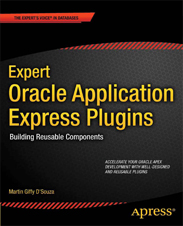One of the most anticipated new features that was introduced in APEX 4.0 was the ability to create your own APEX objects using the plugins framework. Since plugins were new when 4.0 was released there were just a handful of examples available online to help you learn how to create them. Today I’m pleased to announce that there’s a new book entirely dedicated to APEX plugin development!
The new book is called Expert Oracle Application Express Plugins. This book covers everything that you’ll need to know in order to build your own plugins. Though the book’s description states that it’s based on 4.0, it does contain new features available in 4.1. The only new items that it doesn’t cover as part of the 4.1 release is Authentication and Authorization plugins.
Instead of copy and pasting the book’s description in this post, I thought I’d give a high level overview of the book’s layout and what each chapter contains. Here is the chapter breakdown:
Chapter 1 – Introduction: This is a short chapter which introduces the book and explains how things are structured along with some assumptions etc. I tried to keep this short to help get readers moving along to learn about plugins as soon as possible.
Chapter 2 – Plugin Fundamentals: This chapters covers how to create a plugin, the different types of plugins, and goes into great detail about each plugin attribute. This is extremely helpful to help get you familiar with all the different options and their effects.
Chapter 3~6 – Examples: In each of these chapters you’ll build a plugin from scratch. Throughout the process you’ll learn some tips and techniques that will help with your own plugins. Some of these plugins can be found on plugins.clarifit.com.
Chapter 7 – Best Practices & Community: As the title suggests, this chapter goes over some best practices to use when developing plugins. It also covers some excellent plugin resources and how you can make your plugin accessible to other APEX developers.
Chapter 8 – Debugging & Tools: I think its extremely important to use the correct tools when creating plugins. Some developers may get frustrated and spend a lot of extra time if they don’t have the correct tools. This chapter discusses some tools that I use to help speed up my development time. It also covers some debugging tools that will help resolve issues efficiently and quickly.

Load comments